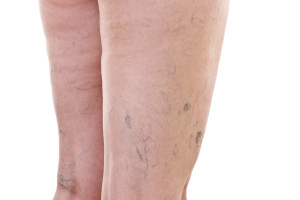-
Cellulite and Vein Issues
Posted on December 10, 2015 by Vein Admin in compression vein treatment, diet and veins, sarasota compression stockings, spider veins, varicose vein facts, varicose veins
 Varicose, Spider veins and Cellulite occur, for the most part, on the legs. These two conditions often present in conjunction with one another. As skin and muscle fibers loosen, vein walls lose support.
Varicose, Spider veins and Cellulite occur, for the most part, on the legs. These two conditions often present in conjunction with one another. As skin and muscle fibers loosen, vein walls lose support.There are three kinds of cellulite. Two of the three often present in conjunction with visible venous issues. Soft Cellulite, Hard Cellulite and Edematous Cellulite. Hard cellulite does not generally correlate to vein conditions.
Soft Cellulite
This type of cellulite bounces as you move and has a gelatinous appearance. It is soft and squishy to the touch. It is often accompanied by varicose veins or spider veins. This type of cellulite seems to be most prevalent after age 40 and more so in women than in men.
What you can do: Slow steady weight loss and adding weight baring exercises to tone will improve appearance of skin and give support to the veins. High quality protein added to the diet is highly recommended. Massage may also help to drain excess fluid and activate lymph and venous circulation.
Edematous cellulite
Least common and hardest to treat, Edematous cellulite results from fluid retention combined with poor circulation. This type of cellulite occurs almost exclusively in the lower legs. Over time legs will lose their shapely appearance and appear more column-like. It can result in thick ankles (cankles). Skin may also be pasty in color, spongy and tender to the touch. These are signs of venous and lymphatic insufficiency in the legs (water-retention, swelling, varicose veins, cramps).
What you can do:- Non-impact exercises like swimming, walking or biking are recommended.
- Compression stockings can also be helpful.
- Shower with alternate hot and cold water
- Supplements such as ginseng, butcher’s broom, pine bark extract and horse chestnut, to help strengthen the vein walls.
- Foods that encourage fluid retention should be avoided, including salty and prepared foods, and fizzy drinks.
- Lymphatic drainage massage
- Acupressure/Acupuncture
- Herbal teas (horsetail and green tea that help reduce fluid-retention)
With both cellulite conditions the likely hood of venous insufficiency disease his very high. We highly recommend visiting www.eveinscreening.com to explore treatment options and complete your FREE Vein Screening by Dr. Joseph Magnant, a board certified vascular surgeon.





